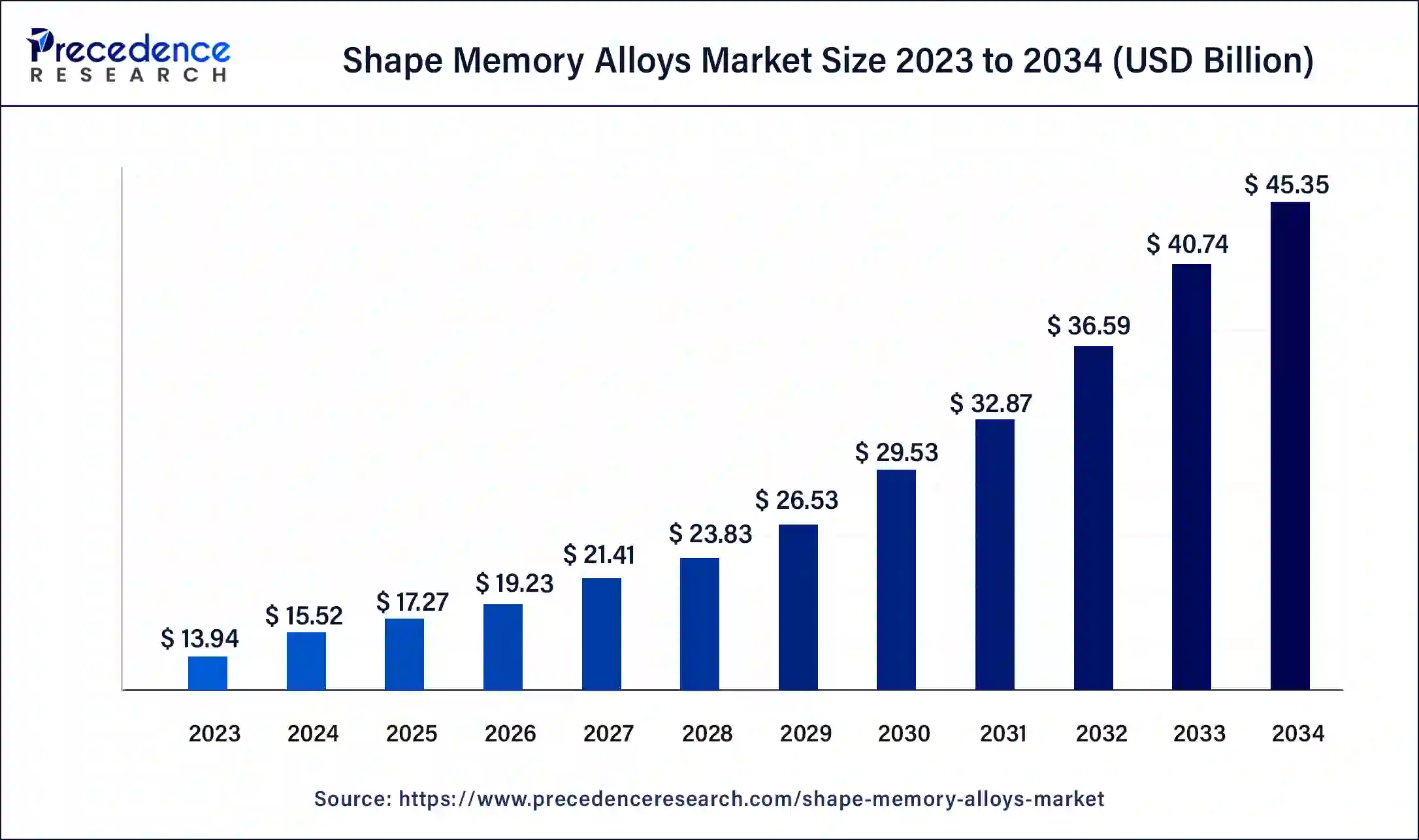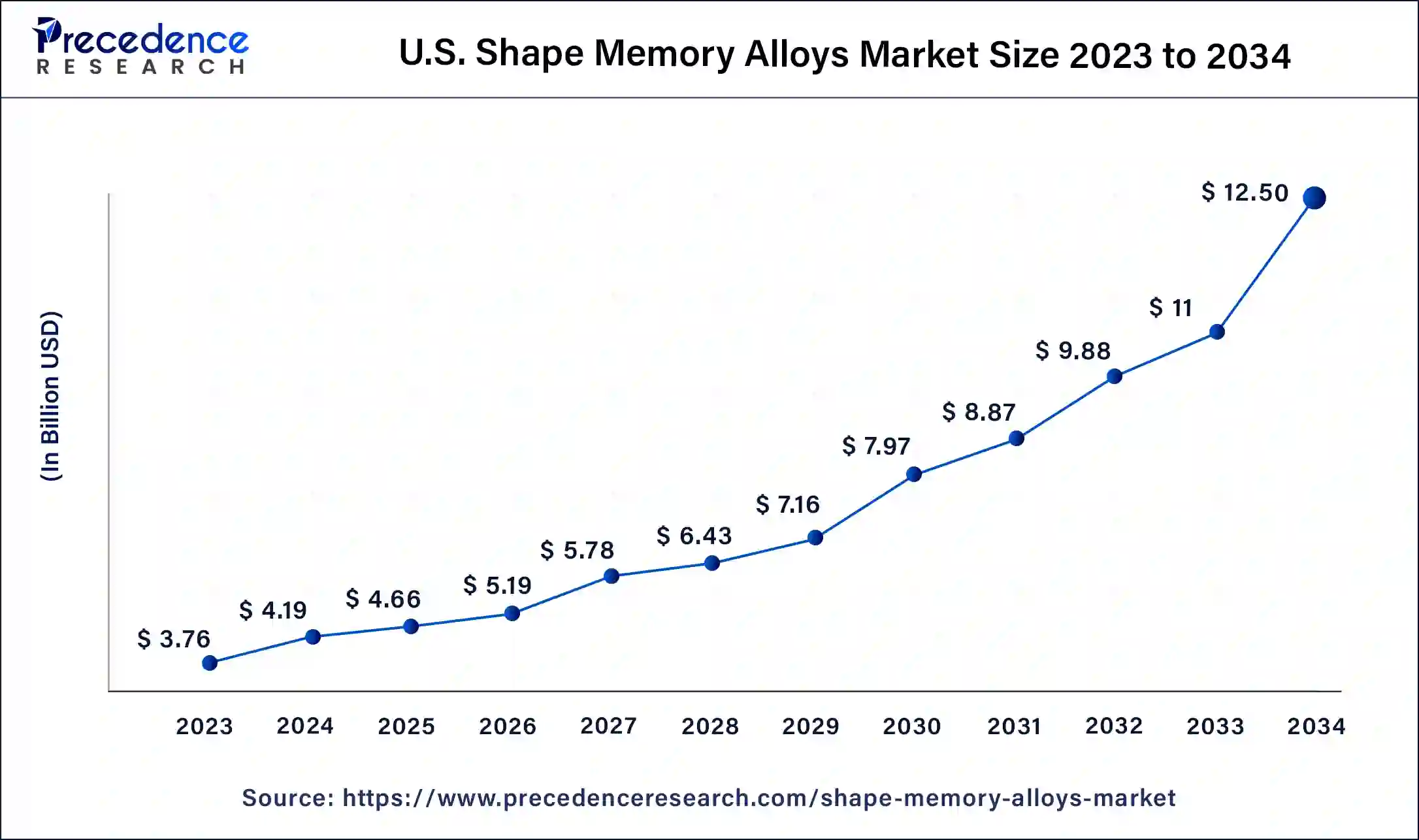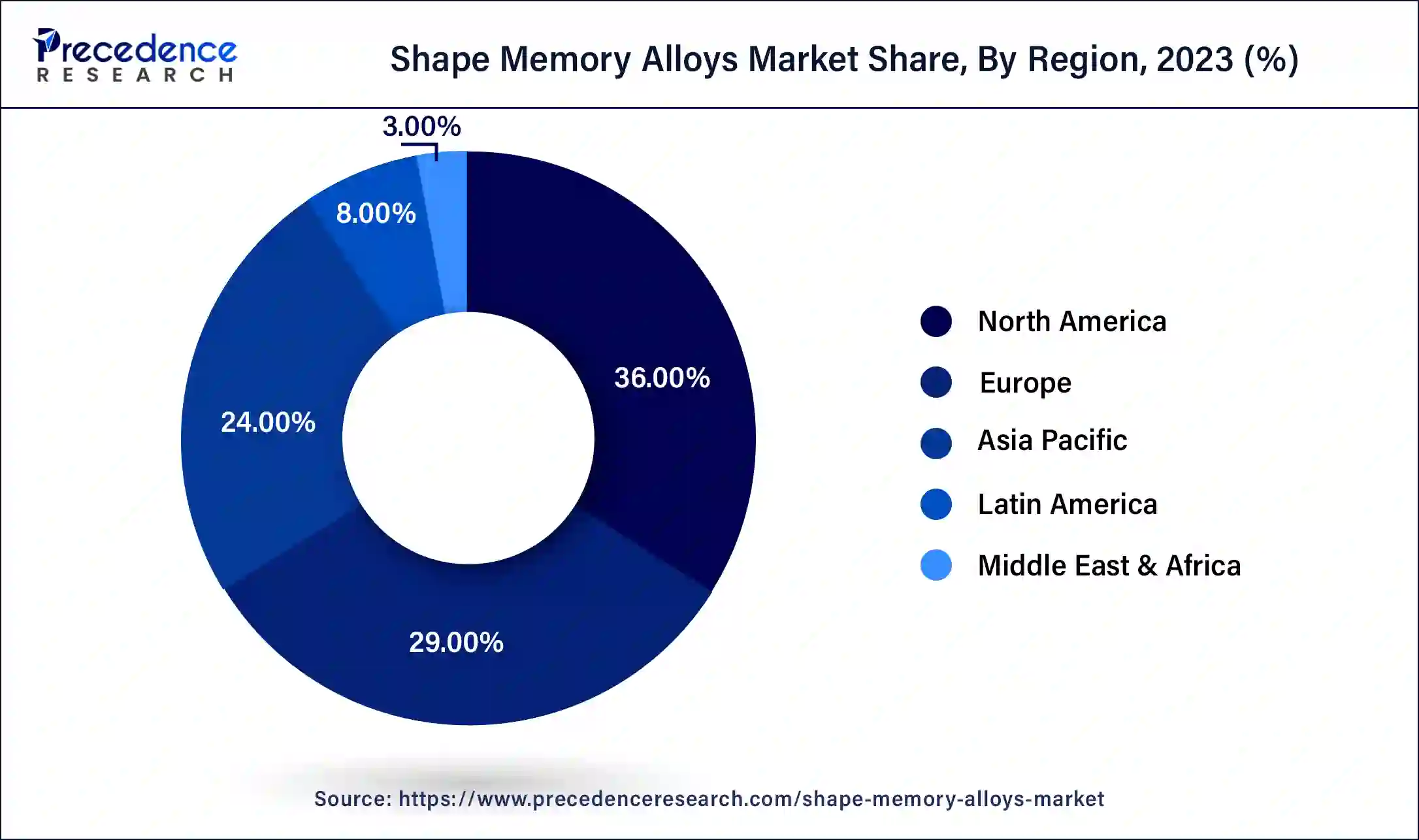List of Contents
Shape Memory Alloys Market Size and Forecast 2025 to 2034
The global shape memory alloys market size is projected to be worth around USD 45.35 billion by 2034 from USD 15.52 billion in 2024, at a CAGR of 11.32% from 2025 to 2034. Increasing investment in healthcare within the biomedical industry is a critical factor in driving the need for the shape memory alloys market.

Shape Memory Alloys Market Key Takeaways
- The global shape memory alloys market was valued at USD 15.52 billion in 2024.
- It is projected to reach USD 45.35 billion by 2034.
- The shape memory alloys market is expected to grow at a CAGR of 11.32% from 2025 to 2034.
- North America dominated the shape memory alloys market with the largest market share 36% in 2024.
- Asia Pacific is expected to show the fastest growth in the market over the forecast period.
- By product, the nickel-titanium (Nitinol) alloys segment has generated more than 89% of market share in 2024.
- By product, the copper-based alloys segment is expected to grow significantly in the market over the forecast period.
- By end use, the biomedical segment held the largest market share of 69% in 2024.
- By end use, the automotive segment is anticipated to grow at the fastest rate in the market during the projected period.
How is AI changing the Shape Memory Alloys Market?
AI process ensures accuracy control over the actuation, shape memory, and mechanical properties of SMA foils. The use of AI reduces the inconsistencies and errors in the manufacturing processes in the shape memory alloys market. Additionally, an AI-guided approach helps consumers save on production costs without compromising on the function or reliability of the materials. It can minimize waste and improve the resource utilization of sustainable manufacturing methods.
U.S. Shape Memory Alloys Market Size and Growth 2025 to 2034
The U.S. shape memory alloys market size was exhibited at USD 4.19 billion in 2024 and is projected to be worth around USD 12.50 billion by 2034, poised to grow at a CAGR of 11.55% from 2025 to 2034.

North America dominated the shape memory alloys market in 2024. The region has advanced technological infrastructure and a wide vendor base, which helps it maintain market dominance. Moreover, North America's ability to embrace advanced technologies strengthens its leadership position in the market. North America, particularly the US, led the position due to rising healthcare spending and obesity among most of the population.
- In May 2022, researchers from the Department of Materials Science and Engineering at Texas A&M University used an artificial intelligence materials selection framework (AIMS) to discover a new shape memory alloy. The shape memory alloy showed the highest efficiency during operation achieved thus far for nickel-titanium-based materials.

Asia Pacific is expected to show the fastest growth in the shape memory alloys market over the forecast period. The growth in the region is driven by growing demand for SMAs in the aerospace, automotive, and healthcare sectors. Furthermore, the region is experiencing a substantial rise in investments in the healthcare sector, which is expected to drive the demand for SMAs in the region soon. China holds a dominant market share in the region because of the availability of low-cost labor, which is the key market driver.
World crude steel production (2023)
| Rank | Countries | Jan-Apr '23 (mt) |
| 1. | China | 354.4 |
| 2. | India | 43.9 |
| 3. | Japan | 28.9 |
| 4. | The U.S. | 26.1 |
| 5. | Russia | 25.1 |
| 6. | South Korea | 22.4 |
| 7. | Germany | 12.4 |
| 8. | Brazil | 10.6 |
| 9. | Turkey | 10.1 |
| 10. | Iran | 9.7 |
Market Overview
These are metallic alloys that can return their original shape or size in response to external stimuli, such as mechanical stress or temperature changes. These notable properties come from eversible martensitic phase transitions. Shape memory alloy's super elasticity makes them beneficial in several disciplines like aerospace engineering, automotive components medicinal devices, and consumer electronics. These alloys are also utilized in various applications due to their distinctive features. The shape memory alloys market offer dependability, versatility, and adaptation across multidisciplinary sectors.
Shape Memory Alloys Market Growth Factors
- Growing applications in aerospace and defense are expected to drive the growth of the shape memory alloys market shortly.
- Innovations in the automobile sector can fuel the growth of the market over the forecast period.
- Advances in material development and ongoing research activities.
Market Scope
| Report Coverage | Details |
| Market Size by 2034 | USD 45.35 Billion |
| Market Size in 2025 | USD 17.27 Billion |
| Market Size in 2024 | USD 15.52 Billion |
| Market Growth Rate from 2025 to 2034 | CAGR of 11.32% |
| Largest Market | North America |
| Base Year | 2024 |
| Forecast Period | 2025 to 2034 |
| Segments Covered | Product, End-use, and Regions |
| Regions Covered | North America, Europe, Asia-Pacific, Latin America, and Middle East & Africa |
Market Dynamics
Driver
Increased Uses of SMA in Orthodontics
Growing matured populations and developing biomedical inserts globally support interest in the shape memory alloys market. These are generally used in biomedical applications, specifically in clinical inserts, which are inferior in their biocompatibility. Additionally, these composites are used for muscular embeds like clinical staples, hip prostheses, muscular screws and plates, and careful instruments. Orthodontic items are used to adjust and fix the teeth and to close unattractive holes.
- In June 2022, Brius Technologies, an innovative orthodontic technology company creating a new category in teeth straightening through AI, announced the launch of Brava, the world's first teeth straightening solution featuring Independent Mover technology for today's youth. The company's patented biomechanical back-of-the-teeth system uses AI and independent mover technology to plan the independent and simultaneous movement of teeth for a patient's ideal smile.
Restraint
Processing complexity can hamper market growth.
Memory alloys are processed utilizing convenient processes to acquire features like form memory effect and super elasticity. Hence, these complexities can make it hard for producers to manage uniformity and quality standards, which can result in key differences in product function and authenticity, which can stagnate the shape memory alloys market growth.
Opportunity
The development of tires
The National Aeronautics and Space Administration (NASA) has created tires that are meant for the rover designed for the Mars mission using alloys. As per information provided by NASA, this tire travels the rugged surface of Mars without any difficulty or damage. Furthermore, NASA mentioned that these tires can undergo deformation up to 30 times before completely breaking. These tires can also be available for commercial use on earth as well. These tires eliminate the adverse effect of inflation over fuel efficiency. Hence, this trend may present the shape memory alloys market opportunities for the future.
- In September 2023, the airless tire technology developed by NASA for its rovers was later commercialized for terrestrial use by the SMART Tire Company (STC). The METL tire is made from a shape memory alloy, making it elastic like rubber yet strong like titanium. According to a Kickstarter campaign, the SMART METL tires designed for bikes have minimal rolling resistance, require no air pressure, ride smoothly like pneumatic tires, and last the lifetime of your vehicle.
Product Insights
The nickel-titanium (Nitinol) alloys segment led the global shape memory alloys market in 2024. The growth of the segment is attributed to the rising investments in research and development activities to create innovative products such as specialty guidewire, wire stents, and micro-coils. Self-expanding stents built from nitinol are utilized to cure peripheral vascular diseases.
- In September 2023, the Federal Trade Commission closed its antitrust investigation into Resonetics' planned USD 900 million purchase of the SAES Getters medical nitinol business. The company did not say whether the FTC would allow the sale without conditions.
The copper-based alloys segment is expected to grow significantly in the shape memory alloys market over the forecast period. This growth can be linked to the rising use of copper-based alloys in actuators, couplings, safety valves, and fluid connectors. This alloy segment includes copper-aluminum and copper-zinc-aluminum (CuZnAl), which is cheap compared to other materials.
End-use Insights
The biomedical segment held the largest share of the shape memory alloys market in 2024 by holding the largest market share. The growth of the segment is driven by the rising use of nitinol in biomedical fields. Moreover, the growing global population, along with orthopedic and dental complications and the rising prevalence of cardiovascular diseases, are also expected to fuel market growth soon.
- In July 2022, a team led by Prof. Bishakh Bhattacharya, Professor, Department of Mechanical Engineering at IIT Kanpur's Smart Materials, Structures and Systems (SMSS) Lab developed a bio-inspired artificial muscle for next-generation space robots and medical prostheses.
The automotive segment is anticipated to grow at the fastest rate in the shape memory alloys market during the projected period. The growing demand for improved performance, safety, and comfort in vehicles is contributing to the expansion of innovative actuators, sensors, and microcontrollers. Additionally, the increasing adoption of the shape memory effect over traditional actuators like hydraulic and pneumatic systems is propelling the segment's growth.
Shape Memory Alloys Market Companies
- ATI
- Fort Wayne Metals Research Products Corp
- Furukawa Electric Co., Ltd.
- Nippon Seisen Co., Ltd.
- SAES Group
- Johnson Matthey
Recent Developments
- In March 2024, Montagu, a private equity firm, announced its plans to acquire the medical device components (MDC) business from Johnson Matthey. MDC develops and manufactures specialized components for minimally invasive medical devices. It focuses on the development of complex and high-precision parts made from platinum group metals and nitinol.
- In December 2023, Fluid-o-Tech, an Italy-based manufacturer of magnetic pumps and drives, announced the expansion of its product offerings beyond traditional magnetic systems. The company has made strategic investments and collaborations to develop new products, including piezo valves, pumps, and SMA-actuated valves.
- In June 2023, Johnson & Johnson launched a new line of cobalt-chromium alloy implants for use in orthopedic procedures. The implants are said to be biocompatible and have a high strength-to-weight ratio.
- In May 2023, Stryker Corporation launched a new line of titanium alloy implants for use in dental procedures. The implants are said to be biocompatible and have a high strength-to-weight ratio.
- In April 2023, Zimmer Biomet Holdings, Inc. launched a new line of stainless-steel implants for use in cardiovascular procedures. The implants are said to be biocompatible and have a high strength-to-weight ratio.
- In January 2022, Exergyn raised USD 35 million in a Series A funding round to commercialize its innovative thermal management solutions. The company uses SMA technology to eliminate the need for destructive refrigerants, significantly reducing carbon emissions across various industries, including heating, ventilation, air conditioning, refrigeration (HVACR), automotive, and aerospace.
Segments Covered in the Report
By Product
- Nickel-Titanium (Nitinol) Alloys
- Copper-Based Alloys
- Others
By End-use
- Biomedical
- Automotive
- Aerospace & Defense
- Consumer Electronics & Household
- Others
By Geography
- North America
- Asia Pacific
- Europe
- Latin America
- Middle East & Africa
For inquiries regarding discounts, bulk purchases, or customization requests, please contact us at sales@precedenceresearch.com
Frequently Asked Questions
Ask For Sample
No cookie-cutter, only authentic analysis – take the 1st step to become a Precedence Research client